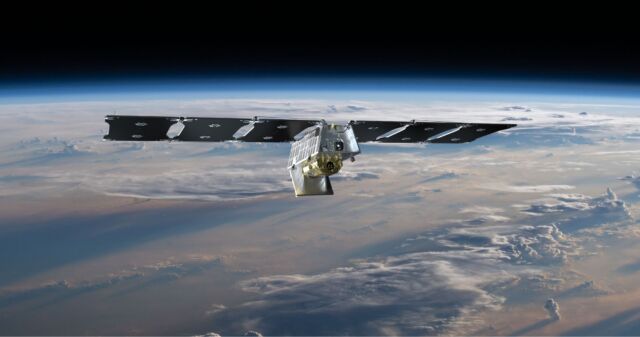

Space is more accessible than ever thanks to the proliferation of small satellites and more affordable launch prices, which opened the door to bespoke applications like global pollution monitoring, crop observations, and new ways of collecting weather and climate data.
Now you can add wildfire detection to the list. Satellites have observed wildfires from space for decades, but a new initiative partially funded by Google’s philanthropic arm aims to deploy more than 50 small satellites in low-Earth orbit to pinpoint flare-ups as small as a classroom anywhere in the world.
The FireSat constellation, managed by a nonprofit called Earth Fire Alliance (EFA), will be the first satellite fleet dedicated to detecting and tracking wildfires. Google announced a fresh investment of $13 million in the FireSat constellation Monday, building on the tech giant’s previous contributions to support the development of custom infrared sensors for the FireSat satellites.
Google’s funding commitment will maintain the schedule for the launch of the first FireSat pathfinder satellite next year, EFA said. The first batch of satellites to form an operational constellation could launch in 2026.
“Today’s announcement marks a significant milestone and step towards transforming the way we interact with fire,” Earth Fire Alliance said in a statement. “As fires become more intense, and spread faster, we believe radical collaboration is key to driving much needed innovation in fire management and climate action.”
A new use case
The FireSat satellites will be built by Muon Space, a California-based satellite manufacturing startup. Each of the Muon Space-built microsatellites will have six-band multispectral infrared instruments, eyeing a swath of Earth some 900 miles (1,500 kilometers) wide, to pinpoint hotspots from wildfires.
The satellites will have the sensitivity to find wildfires as small as 16 by 16 feet (5 by 5 meters). The network will use Google AI to rapidly compare observations ofany area of this size with previous imagery to determine if there is a fire, according to Google. AI will also take into account factors like nearby infrastructure and local weather in each fire assessment.
Google said it validated its detection model for smaller fires and established a baseline dataset for the AI by flying sensors over controlled burns. FireSat’s partners announced the constellation in May after five years of development. The Environmental Defense Fund, the Moore Foundation, and the Minderoo Foundation also support the FireSat program.
After detecting a wildfire, it’s crucial for FireSat to quickly disseminate the location and size of a fire to emergency responders. With the first three satellites, the FireSat constellation will observe every point on Earth at least twice per day. “At full capability with 50+ satellites, the revisit times for most of the globe improve to 20 minutes, with the most wildfire-prone regions benefitting from sampling intervals as short as nine minutes,” Muon Space said in a statement.

Muon Space
NASA operates a fire-detection system using satellite observations from the agency’s Earth-observing missions, but none offer the sensitivity, resolution, or response time of FireSat. More than 200 commercial Earth-imaging satellites owned by Planet provide fresh views of almost all of Earth’s land masses daily. These satellites can also detect wildfires, but the imagers on Planet’s spacecraft have a narrower field of view than those envisioned by FireSat.
The roster of nonprofit and philanthropic backers of the FireSat constellation bears a resemblance to the group of foundations that funded MethaneSAT, which launched earlier this year. MethaneSAT, as its name suggests, is monitoring methane emissions from space, and the project was mainly financed by private contributions. Google is also a partner in MethaneSAT, where it is integrating AI technology into data analysis, and making the data accessible with Google Earth.
All of this is made possible thanks to lower barriers to entry to spaceflight for small businesses, research institutions, and philanthropic endeavors. There’s more private investment in satellite manufacturing companies than in any other sector of the space market, including launch. The proliferation of satellite manufacturers has made it more affordable to purchase a spacecraft or a fleet of satellites.
And it’s cheaper to put a satellite into orbit. SpaceX charges $1 million to launch a roughly 366-pound (166-kilogram) payload on one of its Transporter rideshare missions on a Falcon 9 rocket, significantly less than any other launch company. MethaneSAT launched on a Transporter rideshare mission earlier this year, and although officials haven’t announced a launch provider for FireSat, SpaceX is the company to beat.